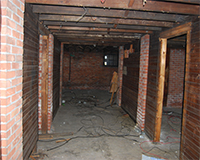 The Royal Borough of Kensington and Chelsea has lost a court challenge after a planning inspector made an exception to its policy that restricts basement excavations to a single storey.
The Royal Borough of Kensington and Chelsea has lost a court challenge after a planning inspector made an exception to its policy that restricts basement excavations to a single storey.
With rising house prices and a lack of development sites forcing Londoners to look below ground for additional space, the ruling will give fresh hope to property owners in the borough that the controversial policy can be overridden in planning appeals.
The authority, which imposed much greater restrictions on basement development after seeing the number of applications to extend underground increase almost tenfold in just over a decade, had attacked a planning permission that allows a three-storey basement at 49 Cheyne Place, SW3.
It is the third time recently that the controversial policy has been aired at the Planning Court. Last July, a judge threw out a challenge to it by Zipporah Lisle-Mainwaring, who made headlines by painting her Kensington townhouse in red and white stripes.
Then, last November, Foxtons founder Jon Hunt fended off an action by the French government that could have meant his own plans for a major basement extension would have had to be reconsidered against the new, more restrictive policy.
In the latest case, a judge ruled that an inspector was entitled to allow a departure from the council’s policy and to accept evidence that the three-storey basement could be excavated without additional disturbance to neighbouring residents compared with the fallback position of what had previously been permitted.
Michael Wyn Harold, who uses the substantial corner property as his London home, had earlier secured planning permission for a two storey basement in 2014, prior to the authority’s adoption of its new basement policy last year.
Among other restrictions, the policy limits basements to no more than one storey, and while the inspector found that the proposal did conflict with that policy, he concluded that “mitigating circumstances” meant there would be no obvious benefits in rigidly enforcing it in this case.
Kensington and Chelsea argued that the three storey scheme will involve an additional depth of excavation of more than four metres, resulting in a further 570 cubic metres of earth being removed, while 15 more concrete deliveries will be required, all causing extra disturbance to neighbours.
As a result, it claimed the inspector’s decision was irrational.
However, dismissing its challenge, Mrs Justice Patterson said that the fact that the proposals were clearly in conflict with the policy “is not and never could be the end of the matter”.
She said: “Having identified that conflict, the inspector went on to consider other material considerations. That was entirely lawful and only to be expected.”
She added that it was entirely open to the inspector to accept Harold’s evidence that the three storey basement could be excavated under the same construction program as a two storey one, and that additional disturbance could be dealt with by conditions.
Referring to the policy, she said that it arose out of “significant development pressure” within the borough. The number of basement planning applications rose from 46 in 2001 to 450 in 2013, and the council, she said, regarded it as the “single greatest cause of concern among residents in living memory”.







